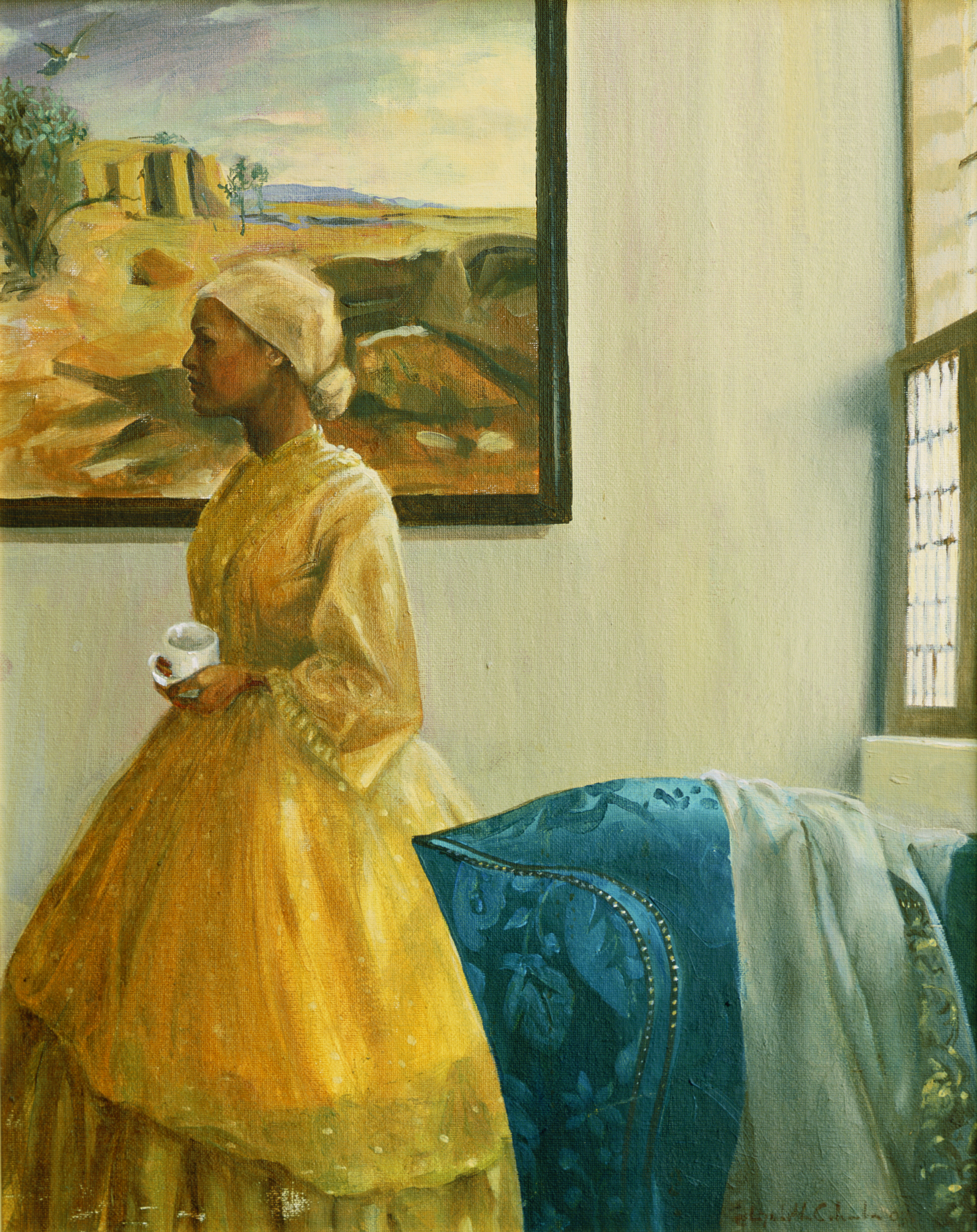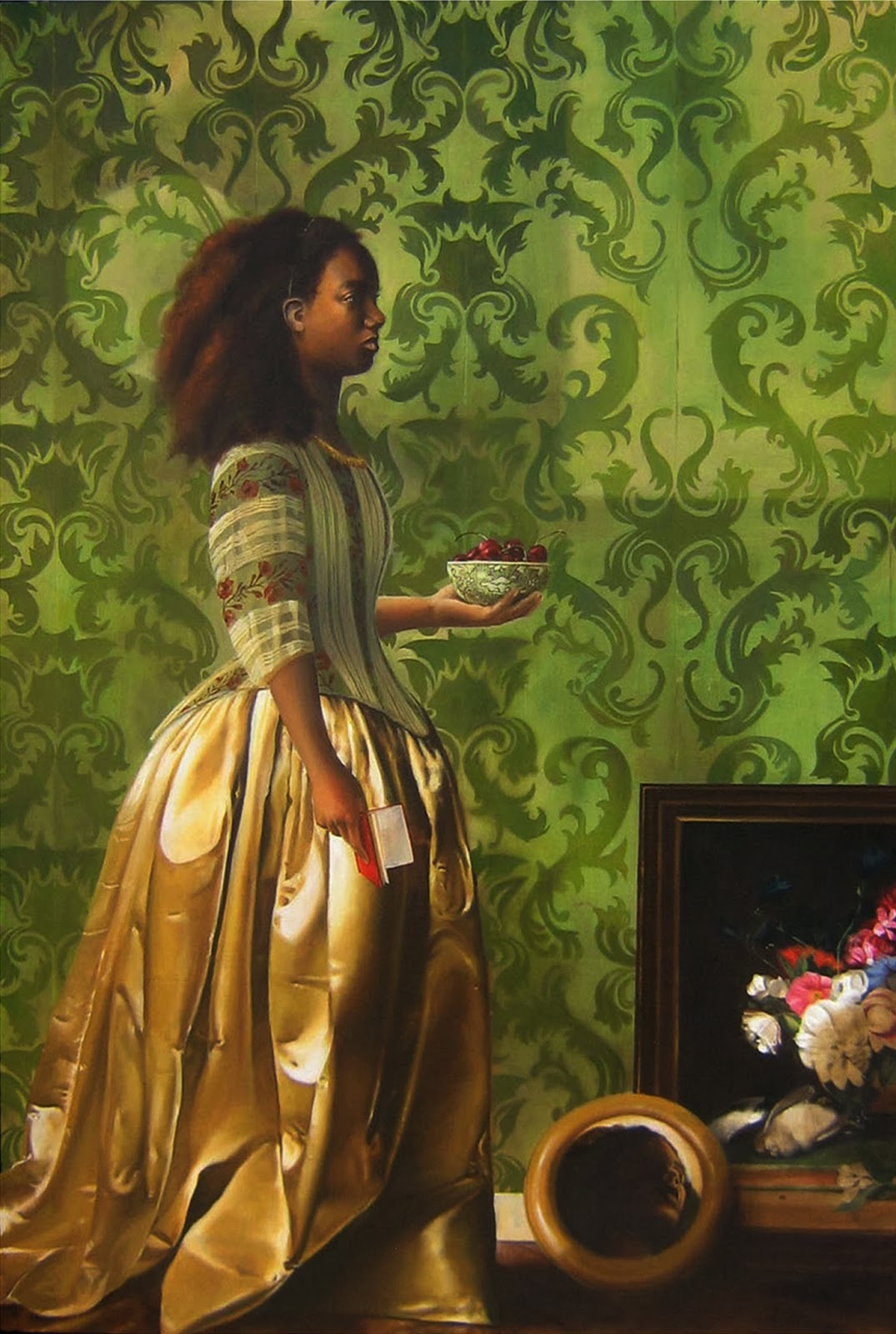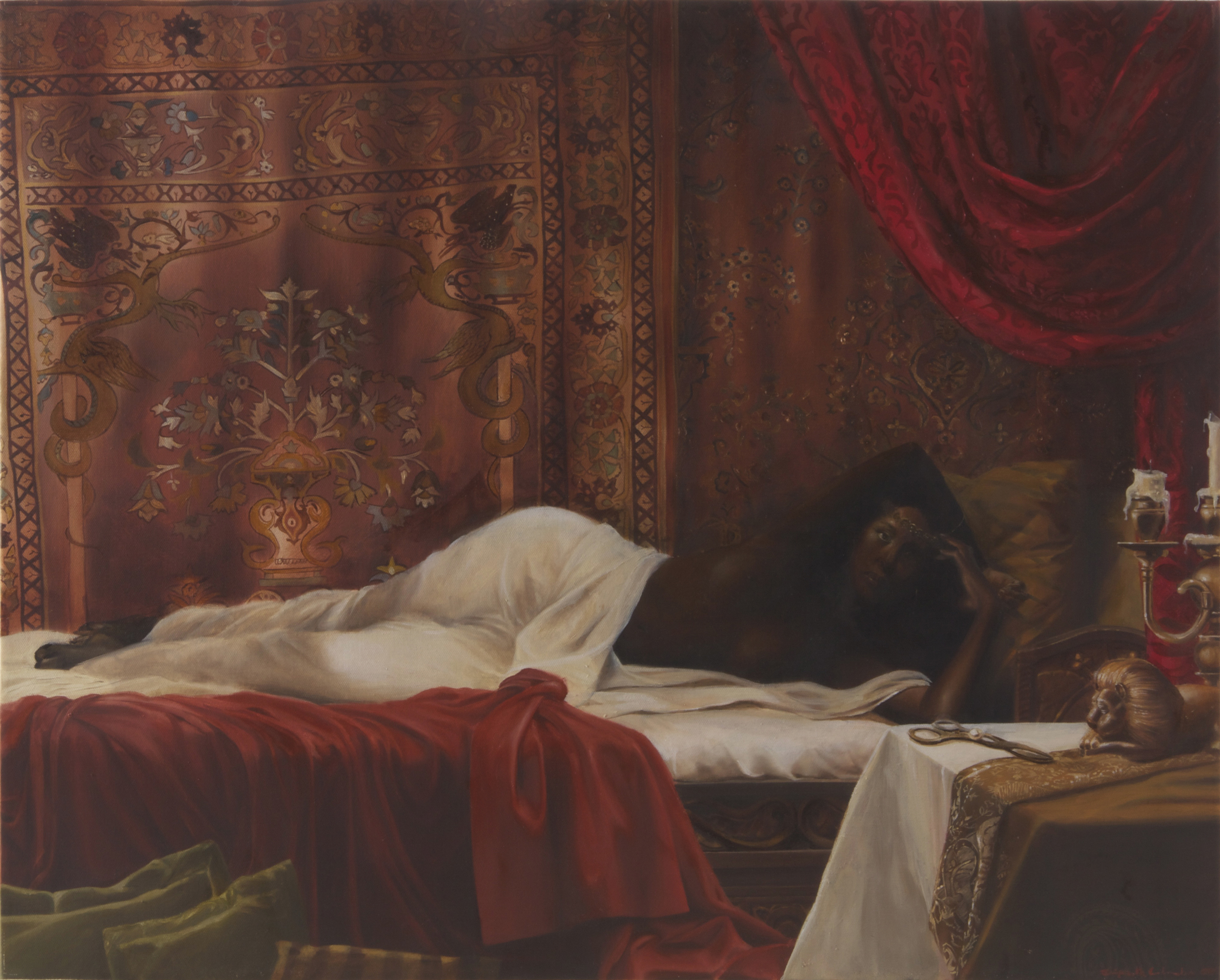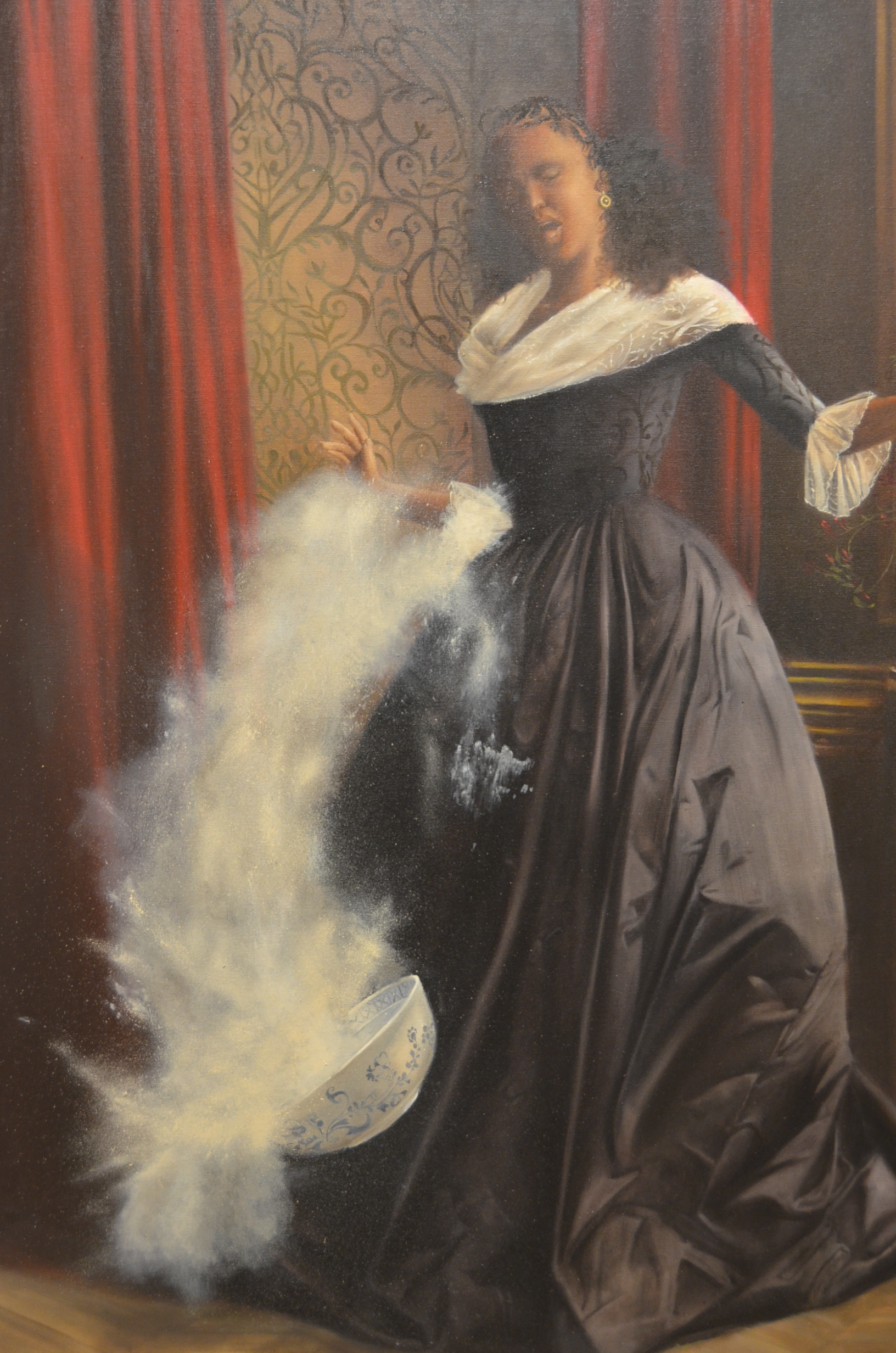Artist Ayana V. Jackson interviews fellow artist Elizabeth Colomba and NY-based curator Monique Long ahead of Colomba’s upcoming exhibition, The Moon is my only luxury opening May 3 at Long Gallery Harlem.
Ayana V Jackson: When looking at Elizabeth’s work one is immediately struck by its beauty but as you peel back the layers and begin to read the work other themes emerge. Can you speak a bit to this?
Monique: In presenting gorgeous figurative paintings, there is the possibility that they will be perceived as simply beautiful. I find this interesting because it doesn’t necessarily happen in other mediums. For example, you can listen to a song by Nina Simone and appreciate the beauty of her composition, melody and voice but also recognise the complexity – her form of activism.
Work like Elizabeth’s can be deceptively simple. The viewer is first drawn in by the lush canvas and then you might see all these ideas she’s proposing. Beauty and politics or beauty and activism are not traditionally synonymous but they can co-exist.
With Elizabeth’s work you are first struck by its beauty but as you enter the work, political and conceptual themes emerge. So, while I’ve been engaging with this work, I have been very interested in this idea of beauty as a kind of resistance and how they can be presented together.
Elizabeth: As I think about this question, I wonder when they began to oppose each other. Obviously art was about beauty for a while. And then people began to move away from that and decided that art was not about beauty any more.
You had to go further, you had to go with the sublime, or the idea of finding beauty in horror. I wonder when it started to separate instead of being hand in hand.
M: It is a question I am interested in. In thinking about the politics of blackness, which I believe Elizabeth is also tackling, the academic Joan Morgan coined the term ‘the liberation ethic’, where an artist or any kind of creative person is held to a standard and rules of presenting their work in a certain way. [The perception is] If you are not working as an activist in an obvious or traditional way, it is not important.
A: You mentioned challenging or revisiting the canon. How do you feel Elizabeth is doing that and what do you consider to be the importance of such an action.
M: I want to propose a conversation about what black mastery is within this larger idea of the canon, an art historical narrative.
E: Do I reconfigure the canon? I don’t know if I reconfigure the canon, but I like the idea definitely, because I think that there is beauty in many things, in the entire human race.
One must find another way to include every human being in beauty – which is detached from the physical or a skin colour or hair colour or even hair texture. I think that is how I would define what I’m doing. Finding a new concept, a new visual expression.
A: So is your work political?
E: Hopefully it is. I would say all good art is political or should be!
A: What is the role of historical narratives in your work? Why women?
E: I like the idea of placing black characters, black figures into history. Historically, before there was photography it was only through painting and illustrations people could be represented. And we are hardly there at all. I remember when I was a young girl I loved going to the library. Specifically I loved the art section. It was beautiful. Once I was looking through the section on classical arts and found two volumes called Black Figures in History.
In an entire library filled with books about art, only two books included black people.
A collection of all the black figures you could find in classical paintings from the beginning of time to today. There were only two volumes. In an entire library filled with books about art, only two books included black people. It ticked me off. So I think that’s where I got, not the idea, but the impulse to do more and attempt to recreate the history, that was forgotten or not presented. I want to change people’s minds by visually introducing black people in historical context.
A: What is it about women specifically that interests you. What strikes you about their narratives?
E: Being female, I’m naturally more inclined to present women. My mother was a huge influence on my life but also I am interested in the struggle of women in general. Throughout history, women have supportive roles, seldom the lead, even if they were key players.
We talk easily about men being heroes, however women do not get equal praise and are hardly represented that way. So I never questioned it. It just came naturally.
A: Can you tell us a bit about your process, research and your materials?
E: Regarding the research, thank God for the internet. I research a lot. I usually start with an idea. Whether it’s historical or about mythology. And I dig a lot of info around iconography, symbolism, and the meaning of objects, colour, animals, plants and so on.
I am fascinated with how in art history you can analyse a painting and discover attributes. Objects and colours are their own language. They can tell you things beyond the superficial representation.
An apple, or a woman caressing a dog is not simply an apple or a dog; it means something. Even in the still lifes of Dutch Masters, a fly means something, a butterfly means something, the fact that this tulip is there, and it’s faded or the presence of the moon… everything has its own language.
Classical art is so rich. And it is so sad that we are losing this.
That’s what I love about painting. It’s a language within itself. If you study it you can discover so many things. Classical art is so rich. And it is so sad that we are losing this. So I have chosen this way of speaking.
A: Monique, you are preparing an exhibition of Elizabeth’s work. Can you tell us about that? Your curatorial focus for it and perhaps we can end with a work that really speaks to you, and that represents where Elizabeth is at this moment.
M: Sure. The name of the exhibition is The Moon is my only luxury. I wanted the title to be poetic and beautiful like the settings in which she places her subjects. The moon is a feminine trope and these references are very present in her work. There will be twenty works, drawings, oil paintings, and watercolors so it is a survey show, spanning 1997 – 2016.
We are focusing on her portraiture, specifically her portraits of women. The newest works are still lifes in the show. It opens May 3 and there will be an artist’s talk scheduled during the course of the exhibition.
A: What works do you come back to?
E: It’s always about the next one. I have many favourites. Some works that I don’t own anymore. When I look at them on the internet, I’m like oh… this one was good. But I don’t know if it’s because of nostalgia or if it’s because of the quality of it. Now I am working a lot with gold leaf so I like the idea of working with something else. Another material than oil painting. So it’s very interesting. It is also really challenging because I am not a master at gold leafing so sometimes it is a bit difficult.
A: Please tell us about the pineapple.
E: The pineapple… well I want to do a series of still lifes about commodities including coconuts and sugarcane. It is about everything that is traded between the West Indies and other countries and how we exploit these things to make money, regardless of the people who are also being exploited. How a simple fruit or a simple thing can really be the desire and demise of a whole population.
People were loaning each other pineapples for display.
At the same time the pineapple was a symbol of luxury, a symbol of wealth, because it was a miracle fruit. The first fascination was with the shape of it, the idea that you can eat such a thing. So for many it really was a real miracle. People were loaning each other pineapples for display. And not eating them because they were so expensive. Just to show their wealth. Later it would be sculpted on buildings and made into ornaments
It interests me how there are two sides. On one hand you have the people who are cultivating it and get nothing from it, and on the other hand it is a commodity and the ultimate symbol of luxury.
My parents are from Martinique, so when I go to the island, I still feel this weird relationship between, I’m going to call them ‘the masters’ and the people from there. Everyone is technically from there when you consider the time we have all been there, but the descendants of the people who owned the plantations are still owners and their presence as a group is felt.
I think these new works speak to that.
So there is still a weird energy. It is still very present. I think these new works speak to that. It makes us understand that we are still in a way in the same dilemma.
M: For me… I love the small works. Daphne is the signature image for the show. I believe it showcases her technical ability beautifully. The way she is able to master watercolour to the point where you aren’t sure what the medium is. It could be oil for instance. It showcases many of the things that Elizabeth is wonderful at. For instance her rendering of fabric in the tradition of Old Masters and still life work within the work.
A: Can you tell us about 1492?
E: It symbolises, of course, Christopher Columbus descending upon the Americas and how something can come out of nowhere and splatter you and stain you forever.
A: Like flour on a black dress.
E: Not only on a black dress, but a silk dress. It’s a precious material and you know it’s not going to be easy to take out. I think it’s just a meditation on how these events really changed the face of the world.
M: [1492] can be perceived as abbreviation for imperialism; it connotes ideas of exploration and the oppression of people.
E: And just having this woman in a beautiful gown handling a bowl of flour. The modernity of it and how it changed history. Eventually changed everything. Like a woman who is just handling flour to make some cake and spills it.
Find out more about the exhibit here







